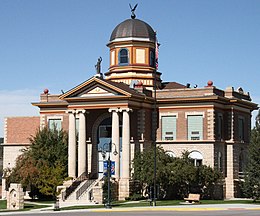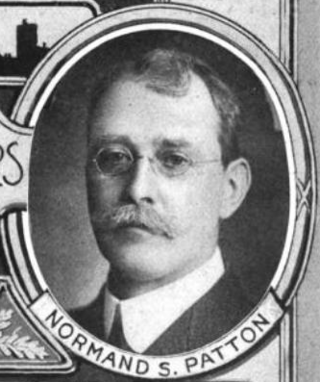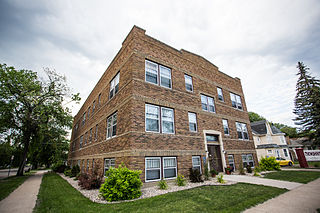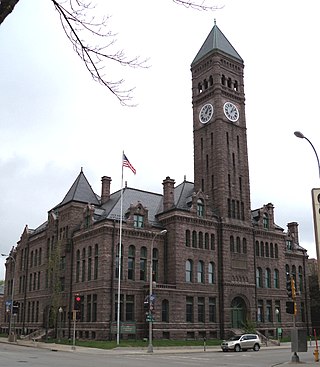Charles A. Randall | |
|---|---|
| Born | July 9, 1871 |
| Nationality | American |
| Occupation | Architect |
| Practice | Rhodes & Randall; C. A. Randall |

Charles A. Randall (born 1871) was an American architect who practiced in Indiana, South Dakota, and Wyoming.
Charles A. Randall | |
|---|---|
| Born | July 9, 1871 |
| Nationality | American |
| Occupation | Architect |
| Practice | Rhodes & Randall; C. A. Randall |

Charles A. Randall (born 1871) was an American architect who practiced in Indiana, South Dakota, and Wyoming.
Randall was born on July 9, 1871, in Logansport, Indiana, to Charles H. and Augusta J. (Thissel) Randall, [1] both natives of New England. [2] After graduating from the public schools, he attended the University of Illinois at Urbana, where he studied architecture. After leaving the University, he spent three years in an architect's office in Chicago. [1] After a short time spent in Lead, South Dakota, where he was briefly married, he returned in 1893 to Logansport. [3] There, he joined the office of architect James H. Rhodes. In 1899 he and Rhodes established a partnership, Rhodes & Randall. [4]
In 1901 this partnership was dissolved, and Randall relocated to Deadwood, South Dakota, near Lead. There, he joined the office of Otho C. Jewett, [1] who had been practicing there since at least 1898. [5] In April 1902 Jewett died, and Randall took over the practice. [1] His first major project in Deadwood was the Franklin Hotel, plans for which Jewett had just begun at the time of his death. [6] He remained in Deadwood until 1905, when he relocated to Casper, Wyoming. From there, in 1909, he went to Newcastle, same state. In 1911 he briefly returned to South Dakota, settling in Belle Fourche. [7] By 1913 he had settled in Sheridan, Wyoming, where he appears to have remained for the rest of his career.
At least three of Randall's buildings have been placed on the National Register of Historic Places, and at least two more contribute to listed historic districts.
| Year | Building | Address | City | State | Notes | Image | Reference |
|---|---|---|---|---|---|---|---|
| 1899 | Linc W. Pilling House | 1012 High St | Logansport | Indiana | [8] | ||
| 1902 | Franklin Hotel | 709 Main St | Deadwood | South Dakota | [6] | ||
| 1903 | Deadwood High School | 716 Main St | Deadwood | South Dakota | Demolished. | [9] | |
| 1903 | Science Hall | Spearfish Normal School | Spearfish | South Dakota | Demolished. | [10] | |
| 1904 | First National Bank Building | 696 Main St | Deadwood | South Dakota | [11] | ||
| 1906 | Casper Public Library | 302 E 2nd St | Casper | Wyoming | Demolished. | [12] | |
| 1907 | Natrona County Courthouse | 200 N Center St | Casper | Wyoming | Demolished. | [13] | |
| 1909 | Weston County Courthouse | 1 W Main St | Newcastle | Wyoming |  | [14] | |
| 1911 | Butte County Courthouse | 839 5th Ave | Belle Fourche | South Dakota |  | [15] | |
| 1911 | Deadwood Auditorium | 105 Sherman St | Deadwood | South Dakota | [16] | ||
| 1914 | Holy Name R. C. School | 121 S Connor St | Sheridan | Wyoming |  | [17] | |
| 1916 | Linden Avenue School | 345 S Linden Ave | Sheridan | Wyoming | Demolished. | [18] | |
| 1916 | Mills Company Building | 30 N Gould St | Sheridan | Wyoming | [18] | ||

Deadwood is a city that serves as county seat of Lawrence County, South Dakota, United States. It was named by early settlers after the dead trees found in its gulch. The city had its heyday from 1876 to 1879, after gold deposits had been discovered there, leading to the Black Hills Gold Rush. At its height, the city had a population of 25,000, attracting Old West figures such as Wyatt Earp, Calamity Jane, and Wild Bill Hickok.
Ethan Bennett Farnum was one of the first residents of Deadwood who was not a miner or prospector; he was the owner of a general store. He was the first mayor of the town of Deadwood.
Charles Randall may refer to:

William Dale Owen was a U.S. Representative from Indiana. Before serving in Congress he was a clergyman, attorney, newspaper editor, and the author of two books. After serving in Congress and as Secretary of State of Indiana, he engaged in various business ventures, including promotion of coffee and rubber plantations in Mexico. In 1905 his business partner was arrested; in 1906 the partner was convicted of fraud and theft, and imprisoned. Owen left the United States to avoid prosecution; what happened to him after he fled the country is not known.

Normand Smith Patton was an American architect based in Chicago, Illinois and Washington, D.C.
Frost & Granger was an American architectural partnership from 1898 to 1910 of brothers-in-law Charles Sumner Frost (1856–1931) and Alfred Hoyt Granger (1867–1939). Frost and Granger were known for their designs of train stations and terminals, including the now-demolished Chicago and North Western Terminal, in Chicago. The firm designed several residences in Hyde Park, Illinois, and many other buildings. Several of their buildings are listed on the U.S. National Register of Historic Places.

Charles Emlen Bell (1858–1932), often known as C.E. Bell, was an American architect of Council Bluffs, Iowa and Minneapolis, Minnesota. He worked alone and in partnership with John H. Kent and Menno S. Detweiler. He also worked as part of Bell, Tyrie and Chapman. A number of his works are listed on the U.S. National Register of Historic Places.

John Marshall (1864–1949) was a Scottish-born American architect in practice in Devils Lake, North Dakota, from 1905 until 1946.

Haxby & Gillespie was an architectural firm from Fargo, North Dakota. R. J. Haxby and William D. Gillespie were the partners. The firm "produced a number of important buildings throughout North Dakota." They designed many notable public, educational, commercial, and church buildings, in North Dakota, Minnesota, and Montana.

Martin & Hall was the architectural partnership of Frank W. Martin and George F. Hall (1866–1928). It was based in Providence, Rhode Island.

Wallace L. Dow (1844-1911), often known as W. L. Dow, was an architect of Sioux Falls, South Dakota. He has been referred to as the "Builder on the Prairie" and was "considered the premier architect of South Dakota in the late 19th century."

St. Anthony's Roman Catholic Church is a historic church at 329 S. 3rd Street in Sterling, Colorado, United States. It was built in 1911 and was added to the National Register of Historic Places in 1982.
Rochford is an unincorporated community in Pennington County, South Dakota, United States. It is not tracked by the U.S. Census Bureau.
The Rapid City, Black Hills and Western Railroad, also known simply as the Black Hills and Western Railroad and commonly referred to as the Rapid Canyon Line or the Crouch Line, is a defunct standard gauge freight railroad line that operated in the Black Hills in the U.S. state of South Dakota. The railroad became known throughout the area for its crookedness and later became a tourist attraction. It ran from Rapid City to Mystic for a distance of 36.043 miles. The railroad ceased operations in 1947.

Cudworth & Woodworth, later Cudworth, Woodworth & Thompson and Cudworth & Thompson, was an architectural firm from Norwich, Connecticut.

Ernest C. S. Holmboe (1873–1954) was an American architect best known for his work in West Virginia.

John L. Pyle was an attorney and politician from the state of South Dakota. A Republican, he was notable for his service as State's Attorney of Hand County (1886-1888) and state Attorney General (1899-1902).

John P. Eisentraut (1870-1958) was an American architect most closely associated with South Dakota. Eisentraut designed a number of buildings, including Carnegie libraries and courthouses, several of which are listed on the National Register of Historic Places. He was one of South Dakota's leading architects during the first quarter of the twentieth century.

John J. Manning was an Irish American frontiersman, lawman, gold prospector, rancher and saloon owner in the American West during the latter part of the 19th century. He was a prominent citizen in Deadwood, South Dakota from his arrival in 1876 to his death. Manning was the first elected sheriff of Lawrence County, Dakota Territory which included Deadwood. He served several terms as sheriff, as well as operated saloons, several livery stables, and a cattle & horse ranch in nearby Belle Fourche in South Dakota.